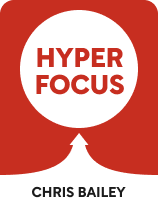

This article is an excerpt from the Shortform book guide to "Hyperfocus" by Chris Bailey. Shortform has the world's best summaries and analyses of books you should be reading.
Like this article? Sign up for a free trial here .
What is the secret to productivity? How can focusing on a single task at a time help you become more productive?
Most of us assume that the secret to productivity lies, at least in part, in managing our time better. But in Hyperfocus, Chris Bailey presents an alternate hypothesis: To focus in a world full of ever-increasing distractions, you must learn not just how to manage your time, but also how to manage your attention.
Here is a brief overview of Hyperfocus by Chris Bailey.
Hyperfocus
Productivity expert Chris Bailey explains why your current method of directing your attention isn’t working—like why you still feel tired no matter how many breaks you take—and then shares several strategies for managing your attention for better productivity and creativity. In our guide, we compare these strategies to recommendations from neuroscientists and other productivity experts, supplementing Bailey’s ideas so that you can manage your attention in the most effective way possible.
In Hyperfocus, Chris Bailey shares two main methods of deliberately managing your attention: hyperfocus and scatterfocus (intentional mind-wandering). When you hyperfocus, you maximize your productivity. And when you scatterfocus, you maximize your creativity.
In this guide, we first discuss how to determine where your attention goes most often. Then, we share the five-step process of hyperfocus. Finally, we describe what intentional mind-wandering is, and how it can boost your rest and your creativity. Throughout, we compare Bailey’s strategies to recommendations from other productivity experts and neuroscientists, noting where they differ and supplementing Bailey’s strategies as needed.
Before You Hyperfocus: Understanding Where Your Attention Goes
In order to understand why you need to deliberately manage your attention, you must first discover how little time you spend deliberately directing your attention now and what you could accomplish if you did. To understand the current state of your attention, Bailey recommends that you first create an attention management matrix.
To create your attention management matrix, sort your tasks into four quadrants.
- Quadrant 1 contains tasks that are unnecessary, which are tasks that are both unproductive and unenjoyable—like sorting your pen drawer.
- Quadrant 2 contains tasks that are distracting, which are enjoyable but unproductive—like distracting smartphone games.
- Quadrant 3 contains tasks that are necessary, which are productive but enjoyable—like filling out medical charts if you’re a doctor.
- Quadrant 4 is tasks that are meaningful, which are both productive and enjoyable. These tasks are the very few tasks that help you fulfill your broader purpose in life—like diagnosing and treating patients if you’re a doctor.
(Shortform note: Bailey’s attention management matrix echoes a time management tool known as the Eisenhower matrix. Originally developed by President Dwight D. Eisenhower, the Eisenhower matrix splits tasks into four quadrants based on their urgency and importance.)
When you’re finished, review the matrix. You likely spend most of your time on Quadrant 1 and 2 tasks, which means you’re operating on autopilot mode: Instead of deliberately directing your attention, you react automatically to external triggers that pique your interest—especially if it’s new, potentially dangerous, or gratifying. (Shortform note: One marketing expert also suggests that you may automatically react to things based on your personal associations with them.) So when you’re in autopilot mode, you naturally focus on less valuable tasks. But when you learn how to deliberately manage your attention, you can focus more on Quadrant 3 and 4 tasks. (Shortform note: We return to this in Step 1 of hyperfocus.)
The 5 Steps of Hyperfocus
How do you deliberately manage your attention? Bailey recommends that you hyperfocus: In hyperfocus, you deliberately direct your attention to a single task. (Shortform note: Bailey’s description of hyperfocus is occasionally contradictory. For clarity, we’ve defined hyperfocus based on what Bailey states is its “most important aspect”—the fact that you’re focused on a single task.)
Why just one task? Because, as Bailey explains, it fits comfortably in your working memory, or “attentional space.” Bailey explains that whenever you do a task, it occupies some portion of your working memory, which holds information your mind is actively processing. Your working memory has a limited working memory capacity: You can only focus on a finite number of things. (Shortform note: Bailey’s definition of “attentional space” combines definitions of short-term and working memory, but since neuroscientists don’t agree on the distinctions between the two terms and Bailey’s main point is that your attentional space is limited, we refer exclusively to working memory.)
If you try to focus on more than you’re capable of, you’ll crowd information out of your working memory and forget it. To avoid this, focus only on what fits in your working memory. And since the amount of working memory a task takes up depends on how complex it is, you can fit only one complex task fully in your working memory. (Shortform note: Research suggests that your working memory capacity peaks at young adulthood and declines as you age—so if you’re older, you might not be able to focus on the same complexity of tasks or the same amount of information as you used to without forgetting it.)
We’ve divided Bailey’s method into the following five-step process:
- Step 0: Choose When to Focus
- Step 1: Choose What to Focus On
- Step 2: Limit and Manage Distractions
- Step 3: Focus for a Set Period
- Step 4: Maintain Your Focus
(Shortform note: Bailey’s method has only four stages, but we added Step 0 since he also presented several recommendations for what to do before you begin hyperfocusing.)
Step 0: Choose When to Hyperfocus
To hyperfocus, first plan when and for how long you’ll hyperfocus.
In Hyperfocus, Chris Bailey suggests that choosing how long to focus is simple: Pick a duration you’re comfortable with and won’t put you off from focusing tomorrow, since hyperfocus works best as a daily habit. As you get used to hyperfocusing, you’ll become used to focusing for longer periods, and the lengths of your hyperfocus sessions will naturally increase. (Shortform note: If you were running a marathon, you wouldn’t run 26.2 miles at once; every day, you’d run just a little bit longer than you did the previous day until you reached a comfortable rhythm. Treat your cognitive endurance the same way.)
Bailey recommends that you choose when to focus based on your schedule, your energy levels, and your tasks. Hyperfocus requires both time and energy, so schedule your hyperfocus sessions when you have both available—in other words, when you have free time and you feel energized. (Shortform note: If you have neither, consider exercising more: Exercise boosts both your energy levels and your productivity—which might give you more free time.) Alternatively, schedule your hyperfocus sessions based on the tasks you need to accomplish. If you have a particularly cognitively demanding task that needs attention, like a presentation, that’s a good time to hyperfocus. (Shortform note: Improve your estimate of how long your hyperfocus sessions should be for each task by discovering the percentage by which you underestimate task length and adjusting accordingly.)
Step 1: Choose What to Focus On
Choosing what to focus on is critical because hyperfocus is most beneficial when we focus on the right task. According to Bailey, the quality of the tasks we pay attention to determines the quality of our lives: When we focus on high-quality tasks, we perform high-quality work and have high-quality impact. (Shortform note: You might argue that you can get everything done, but Essentialism argues that you must set priorities for your own life—if you don’t, others will do so for you.)
So how exactly do you pick the right task? One strategy Bailey suggests is to hyperfocus on the meaningful tasks from your attention management matrix. Another is to consider the impact of your tasks: Focus on tasks that will have the biggest positive impact. To evaluate this, look at both the task’s immediate and long-term effects—the long-term effect is the real impact of your task. (Shortform note: Getting Things Done also recommends choosing your tasks based on their priority levels, but it takes a bottom-up approach: Focusing on your low-priority actions first frees your mind to think about what your higher-level priorities are.)
In Hyperfocus, Chris Bailey also recommends ensuring that you hyperfocus on your most important tasks by setting three goals each day. When you can select only three goals for the day, you’re forced to prioritize. When you know what goals are high-priority, you know what tasks will best support those goals. These are the tasks most deserving of hyperfocus. You also learn what is less important, so you learn what not to focus on. (Shortform note: Setting three priorities might seem impossibly small, but Essentialism explains that this is a new concept: The word “priority” only had a singular form until the 1900s, when we started insisting that we could have many “first” things.)
Step 2a: Limit Distractions
In Step 2a of hyperfocus, you limit distractions—which Bailey defines as anything that diverts you from the task you defined in Step 1. Bailey explains that limiting distractions is critical to hyperfocus because we’re terrible at avoiding distractions if they’re available to us: If you work on a computer, you get distracted every 40 seconds. (Shortform note: Your distractibility also increases with age.) One reason is that we have a “novelty bias”: Whenever you do something new, like giving in to a distraction, your brain gives you a hit of dopamine—so getting distracted feels good. (Shortform note: Conversely, making distractions feel bad should help us avoid them. Consider punishing yourself every time you get distracted: Humans find the possibility of avoiding loss (or avoiding punishment) more motivational than potential gain.)
So how, exactly, do you limit distractions? Bailey recommends that when you encounter a distraction you can’t control, keep your original purpose in mind so that you can return to it when the distraction goes away. This should be easy for unenjoyable distractions—like loud colleagues—but might be more difficult if you enjoy the distraction. In this case, Bailey recommends letting yourself enjoy the distraction but urges you to remember your original goal. (Shortform note: Bailey admits that given his focus on productivity, even the enjoyable distractions annoy him because he dislikes interruptions to his schedule. So this suggestion may not be as helpful if you’re more flexible and already enjoying the distraction.)
(Shortform note: One alternative strategy is to control what you can about the distraction: Even distractions that initially seem unavoidable usually have some element you can control. Another option is to reschedule your hyperfocus session. If, despite your best efforts, an unavoidable distraction crops up mid-hyperfocus session, adjust your schedule. That way, you can give your full attention to whoever interrupts you—and hyperfocus on your initial task at a different time.)
Step 2b: Manage Distractions
What’s the best way to deal with distractions you do have control over? Bailey explains that the most important element is to deal with them before you start trying to focus. Bailey implies that your brain wants to conserve energy, so it resists energy-guzzling hard tasks by looking for less energy-guzzling stimuli—like an easy smartphone game. Therefore, Bailey argues, your brain finds distractions most tempting when you’re resisting a complex task—like when you start trying to hyperfocus. So deal with distractions before you start hyperfocusing, when they’re less tempting. (Shortform note: If you can’t deal with distractions before hyperfocusing, try eating sugar to re-energize your brain: If your brain is prone to distraction because it wants to conserve energy, the more energy you have, the less distractible you should be.)
We’ve listed some of Bailey’s specific strategies below. (Shortform note: Bailey separates his strategies based on whether you want to totally avoid distractions during hyperfocus or merely limit them during regular work sessions. Since both involve limiting distractions—but to different extents—we’ve combined these strategies into methods for limiting distractions to the furthest extent possible.)
Track your distractions. Your brain views commitments and tasks you haven’t yet externalized as threats—so it naturally focuses on them. (Shortform note: Bailey got this idea from Getting Things Done, which shares a five-step task management system: Externalizing your tasks is just Step 1.) Reduce this tendency by writing your potential and actual distractions down: Before you hyperfocus, write down anything that could distract you—like incomplete to-dos. While you hyperfocus, write down any thought that does distract you. By writing them down, you deal with the perceived threat, so you reduce your mental load and can focus better. (Shortform note: Indistractable suggests scheduling 20 minutes each week to reflect on what distracted you and adjusting your schedule—perhaps by scheduling time to list your to-dos—accordingly.)
Distance your distractions. As Bailey explains, our brains are constantly looking for more interesting things to focus on. So make distractions as inconvenient to access as possible—perhaps by removing them together by disconnecting from the Internet. (Shortform note: Distancing your distractions makes accessing them inconvenient, and making bad habits inconvenient is an oft-cited strategy for breaking them: Switch also discusses creating change-supporting spaces that make good behavior easy and undesirable behavior difficult.)
Delegate. Bailey points out that many of our tools perform similar or identical tasks—you probably can text on your cell phone and computer. Bailey argues that this redundancy increases our likelihood of giving in to a tempting distraction because we’re tempted twice. To reduce this redundancy, carefully evaluate whether you need the tool at all. If two of your devices do similar tasks, do you really need both of them? (Shortform note: Digital Minimalism takes this idea one step further, recommending that you identify your priorities and discover which digital tools promote or inhibit these priorities.)
Be more intentional. Since Bailey defines a distraction as something that diverts you from your original purpose, actions like watching TV aren’t distractions if you meant to do them in the first place. (Shortform note: Indistractable makes a similar argument, suggesting that you schedule every activity—even ones like social media—you do each day.) Therefore, Bailey recommends being more intentional about when you do potentially distracting activities—like by scheduling when you respond to emails. (Shortform note: Indistractable explains that people are wired to imitate each other: If you wait to respond to an email, expect not to receive immediate responses, either.) You might also turn off notifications: Choose when to check your apps instead of responding to notifications out of habit.
Hyperfocus on the distraction. Emails and meetings can be distracting, but they’re sometimes essential tasks you must complete. So, counterintuitively, Bailey recommends hyperfocusing on these potential distractions. Try hyperfocusing on meetings you can’t get out of to get the most value from them. (Shortform note: Improve your ability to focus on tedious meetings by actively looking for drama and disagreement during them, which may keep you engaged.) He also recommends hyperfocusing on emails if you have many to respond to. This strategy is especially effective when combined with scheduling if your job requires quick responses to emails. (Shortform note: If you’re inundated by emails, try viewing your inbox as a temporary workspace you use to sort your emails before dealing with them instead of a storage space.)
Step 3: Use Mindfulness to Improve Focus
In Step 3 of hyperfocus, you focus on your intended task for a set period. To make this easier, Bailey recommends incorporating two daily habits: mindfulness and meditation.
To meditate, focus on a single thing and bring your attention back to it when your mind wanders. Specifically, Bailey recommends focusing on your breathing for a small duration of time each day. Conversely, mindfulness is when you pay attention to everything you experience in a given moment. Bailey recommends picking a simple daily task and being mindful during it: Notice everything that happens as you, for example, wash the dishes. (Shortform note: Not everybody agrees with Bailey’s definitions of meditation and mindfulness: One expert defines meditation as intentionally doing something good for yourself and mindfulness as a general awareness of your circumstances.)
In Hyperfocus, Chris Bailey explains that both meditation and mindfulness are good for hyperfocus because they increase your working memory capacity. (Shortform note: Bailey also suggests that hyperfocus might increase your working memory capacity, but he doesn’t delve deeply into the topic—perhaps because both meditation and mindfulness are scientifically validated methods for increasing your working memory capacity, but hyperfocus is not.)
Improving your working memory is important for three reasons:
- The more working memory you have, the more complex the task you can pay attention to since more complex tasks take up more working memory. (Shortform note: This may work best if the complex task is new: The better you get at a complex task, the less working memory it takes up.)
- The more working memory you have, the less likely a distraction is to crowd out your original intention—so you remember your original intention even if you do get distracted and can refocus your attention faster. (Shortform note: Research suggests that the opposite may also be true: A working memory deficit is associated with ADHD, of which one symptom is distractibility.)
- The more working memory you have, the more productive you are—partly because when you’re focused on a task that doesn’t totally fill your working memory, you have even more spare working memory to think about the task so you can make better decisions about it. (Shortform note: Bailey equates thinking more about your task with better decisions, but overthinking your task could prevent you from making any decisions at all.)
Step 4: Maintain Your Focus
In addition to redirecting your attention to your task when you become distracted, an ability that practicing meditation and mindfulness improves, a second piece of maintaining focus is to prevent your mind from wandering. Bailey recommends doing this by matching your tasks to your skill level and increasing how many high-impact tasks you do.
Match your tasks to your skill level. If your mind wanders a lot as you focus on various tasks, you might be bored or anxious. Citing Flow, Bailey explains that boredom occurs when your tasks are too easy, and stress occurs when your tasks are too difficult. Both are known causes of mind-wandering. Therefore, excessive mind-wandering may be a sign that your current job is too easy or too hard. Reduce mind-wandering by adjusting your daily tasks to your current skill level. (Shortform note: Even if you find that your job is not matching your skill level, you don’t have to quit. One Harvard Business Review article suggests having two careers can make you happier and more fulfilled.)
Increase how many high-impact tasks you do. Hyperfocus improves your productivity, so you may find yourself with more free time. But if you’re hyperfocusing and just as busy as you used to be, you might be unconsciously filling this newfound free time with unimportant tasks or distractions—and since your mind wanders when you’re unsure if your current task is the highest-impact option, this lack of important work might increase how frequently your mind wanders. Therefore, Bailey suggests evaluating how much time you spend doing lower-impact tasks. If it’s higher than you like, increase the number of high-impact tasks on your plate.
(Shortform note: To discover whether you’re filling your time with unimportant tasks or distractions—and the tasks you should do instead—regularly recreate the attention management matrix, sorting your tasks by how productive and enjoyable they are. By doing so, you ensure you’re maintaining an acceptable level of productivity—and you always have a list of high-impact tasks to focus on.)
Understanding Intentional Mind-Wandering
In addition to hyperfocusing, Bailey shares another way to deliberately manage your attention: intentional mind-wandering, or “scatterfocus.” In scatterfocus, you deliberately leave room in your working memory to allow your mind to wander. (Shortform note: Bailey skips the neuroscientific explanation of exactly why your mind wanders when you give it that space, perhaps because even neuroscientists don’t agree on how that relationship works.)
Bailey disapproves of mind-wandering when it distracts you from your original intention. But when you mind-wander intentionally, you can experience its benefits. Mind-wandering lets us rest and increases our creativity, which we return to in later sections. Technically, you experience these benefits during unintentional mind-wandering too, but Bailey suggests that intentional mind-wandering maximizes these benefits because you remember what you thought of: If your mind wanders unintentionally, you might not notice it’s wandered—so you’re far less likely to remember any useful insights. (Shortform note: Bailey doesn’t suggest using memorization techniques to remember these insights—perhaps because you’d likely have to transform the insight into an easy-to-remember form, which requires focus and could disrupt your mind-wandering.)
Bailey suggests two main ways to intentionally mind-wander. First, try a fun, cognitively simple task that takes up little working memory, leaving the rest of your working memory free to let your mind wander. Regularly check in to see what you’re thinking about, and keep a pad of paper on hand to jot down any great ideas. (Shortform note: What counts as a fun, cognitively simple task? One that Bailey recommends is walking, which both Charles Darwin and Friedrich Nietzsche regularly did. On his blog, Bailey also extols the benefits of knitting.)
Secondly, schedule time to record your ideas. Bailey recommends scheduling two 15-minute blocks each week with just your thoughts and a notepad. During this time, don’t think about anything in particular. Instead, write down whatever useful thoughts pop into your head so you don’t forget them. (Shortform note: To use mind-wandering as a tool to achieve your long-term goals, read books that discuss the importance of having long-term goals, like 12 Rules for Life: Having long-term goals in the back of your mind may trigger mind-wandering towards actionable to-dos about the future.)
How to Intentionally Mind-Wander for Better Rest
Another major benefit of intentional mind-wandering is that it helps you rest. When you focus on a task, you regulate your behavior—which takes a toll on your brain. When you let your mind roam free, you stop regulating your behavior, so mind-wandering gives your brain a break and helps you recharge. (Shortform note: Since your brain uses 20% of your total energy, you might assume that spending more mental energy regulating your behavior will burn many more calories—but your brain mostly uses its calories for more basic activities like staying awake.)
So how, exactly, can you intentionally mind-wander for rest? First, Bailey recommends that you pick an easy and enjoyable task you can do at work, since that’s likely where you want to recharge your energy. (Shortform note: For best results, consider something physical that gets you away from your desk, like staring out the window or rubbing lotion into your hands.)
As for when to mind-wander: Bailey recommends regular sessions throughout your workday to maximize your productivity—but the exact times depend on individual factors like your workload and energy levels on a particular day. Bailey recommends two main strategies to discover your ideal break time:
Experiment. As Bailey explains, it’s best to rest when you have low mental energy. But since regulating your behavior consumes mental energy, the amount you use every day varies. Generally speaking, tasks that require more focus use more energy than simple tasks. But if you hate your job and have to force yourself to do even the simplest task, you will tire very quickly. So experimenting is the best way to find the break time that maximizes your productivity. (Shortform note: As you experiment, keep a journal to track exactly what you do and how it affects your productivity. As we’ve seen, our memory is limited, so relying on it may be a losing strategy.)
Pay attention to when your energy begins to falter. Bailey explains that, just as we sleep in 90-minute cycles, our mental energy occurs in 90-minute cycles. We feel energized for 90 minutes, then tired for about 20. As such, Bailey recommends paying attention to your energy levels throughout the day and resting when they start to decrease. Specifically, Bailey recommends resting every 90 minutes to take advantage of this natural rhythm. This natural rhythm Is not as regular in the afternoon, but Bailey recommends following it anyway for the sake of consistency. (Shortform note: This energy cycle is biologically known as your ultradian rhythm, and it’s another reason why taking regular breaks is so important. Research shows that if you power through dips in energy, your next energy peak isn’t as high as it is when you rest appropriately.)
How to Intentionally Mind-Wander for More Creativity
A third major benefit of intentional mind-wandering is that it increases your creativity. This has to do with how learning and creativity work in the brain: Whenever you encounter a new stimulus, your brain stores this information in a “dot,” or bit. When you learn, you connect new bits to related bits you’ve already stored. (Shortform note: This is why memorization techniques ask you to connect new information to information you already know: The more connections a bit has in your brain, the more likely you are to remember it.) Creativity comes when you connect unrelated bits together—which is why intentional mind-wandering leads to moments of inspiration: By not focusing on anything in particular, your brain randomly looks for connections—and when it connects two unrelated bits, you gain a new, creative insight. (Shortform note: Creativity isn’t just useful in the arts—one researcher posits that mind-wandering is so common because it was useful in ancient times: We found creative solutions that helped us survive thanks to mind-wandering.)
Strategy #1
So how, exactly, do you intentionally mind-wander for more creativity? Bailey suggests that the first key is to increase the quality of the information you encounter: You create bits when you encounter new information, and you think creatively when you connect those bits in unexpected ways—so if you increase the quality of your information, you’ll gain higher-quality bits and have higher-quality ideas. Bailey argues that the quality of your information depends on how useful it is, stating that the most useful (and thus highest-quality) information is accurate, related to your goals, practical, and relevant long-term. (Shortform note: Although this is a generally applicable rule, rating the value of information is an extremely subjective process. If you personally find a piece of information useful, that’s enough. Don’t feel like information that doesn’t meet all of these criteria can’t be useful.)
Despite this, Bailey doesn’t suggest exclusively taking in high-quality information: Low-quality information is often fun. (Shortform note: Lower-quality information like watching TV can also help you relax if you’re facing a major stressor.) Rather, he recommends that you be more intentional about the information you take in. To do so, spend a few weeks asking yourself the following questions before you consume any information.
- Do I enjoy this? Bailey explains that sometimes, we consume information out of habit and not because we genuinely enjoy it. Stop doing this. (Shortform note: If you struggle with this, try the previous strategies for reducing distractions to help cull the information you consume.)
- Is this worth finishing? Give yourself permission to walk away from information that is ultimately not valuable. (Shortform note: If you’re reluctant to walk away from, say, a TV show because you’re curious about what happens, Google spoilers.)
- Is this worth my time, focus, and energy? Bailey urges you to vet any media before you consume it to make sure you actually want to consume it. (Shortform note: Bailey first introduces this idea by asking readers if they really want to read his book—a testament to Bailey’s commitment to his mission.)
- Is this related to what I know already? Bailey explains that you gain the most creative insights when you connect the ideas that are the most different. So venturing outside your comfort zone and learning new things is key to gaining more creative insights. (Shortform note: This is true of both topics and creators. In 2020, many Americans deliberately diversified the media that they consumed—not by topic but by consuming more media created by BIPOC.)
- Do I want to do this? Since Bailey defines productivity as accomplishing your intended goal, relaxation can be productive. The key? Don’t let yourself fall into autopilot mode. To accomplish this, schedule your relaxation periods in advance and stick to them. It’s OK to binge-watch a TV show as long as you decide how many episodes to binge in advance. (Shortform note: A lot of distractions suck us into long unintended bouts of relaxation because they autoplay. Turn off this setting—having to click play again might help you reconsider whether this Is how you really want to be spending your time.)
Strategy #2
Bailey also suggests that you trigger creative insights by intentionally mind-wandering due to the Zeigarnik effect. The Zeigarnik effect is this: We remember things we haven’t yet completed much better than the things we’ve completed—so our brain continues to work on problems it hasn’t solved even if we’re not actively working on them.
As you subconsciously work on this problem, your brain encounters various stimuli, and it connects all of these stimuli to your problem. Sometimes, the stimulus your brain encounters reminds it of something else it already knows. It connects this old information (or the new stimulus, which may itself be the information you were missing) to your problem—and solves it.
Intentional mind-wandering maximizes the possibility of encountering the stimulus you need for a creative insight because, when you perform a fun, easy, task, you maximize the number of stimuli you encounter: You experience both external stimuli (from doing the task) and internal stimuli (the thoughts you have as your mind wanders). The more stimuli you encounter, the more likely you’ll encounter the one you need.
(Shortform note: Despite the Zeigarnik effect’s popularity in productivity books, most modern psychology books don’t mention it because researchers haven’t been able to replicate it reliably.)
For best results, Bailey recommends the following strategies:
Intentionally mind-wander in busy environments. You need new stimuli to trigger a creative insight, so maximize your chances of having a burst of inspiration by maximizing the external stimuli you encounter. Bailey recommends intentionally mind-wandering someplace you’ll regularly encounter new cues—like a train station or a busy café. (Shortorm note: If you work from home, expand your weak-tie network through cross-departmental collaborative projects to increase new stimuli: Chance comments from “weak ties” can be the source of unexpected inspiration.)
Manipulate the Zeigarnik effect. One way to manipulate the Zeigarnik effect is to write down a problem you’re stuck on. Writing down your problem helps you remember the problem so it stays in the back of your mind. (Shortform note: This strategy may only work if you’re handwriting, which improves your memory: Typing doesn’t have the same effect.) Then, move onto a fun but easy task and let your mind wander: The Zeigarnik effect will ensure that your brain will try to connect both the external stimuli (the task) and the internal stimuli (your thoughts) you encounter to your problem—and the more connections your brain makes, the more likely it is to make a useful connection.
(Shortform note: Like Bailey, Barbara Oakley’s A Mind for Numbers argues that you can switch to diffuse-mode thinking (which is similar to intentional mind-wandering) to work out a creative solution to a problem. But Oakley’s technique has one important caveat: She argues that in order for your mind to best come up with a creative insight, you can no longer be consciously thinking about the problem—which can take several hours.)
Sleep on it. You might argue that sleeping is a biological necessity and doesn’t count as intentional mind-wandering. But Bailey argues that dreaming is “scatterfocus on steroids,” noting several famous examples of great ideas humans had in their sleep. (Shortform note: One he doesn’t mention is Mary Shelley, who dreamt up her gothic classic Frankenstein during an afternoon nap.) Bailey suggests that dreaming may trigger creative insights because sleep is so neurally similar to intentional mind-wandering. Both intentional mind-wandering and sleep energize us. Random neurons fire both when we sleep and when we mind-wander intentionally, which leads to breakthrough ideas. Our brains consolidate information during both brain modes. Our minds wander to similar areas during both modes, including the past, the future, and our relationships with other people. However, Bailey admits that our minds jump much more between these areas when we mind-wander intentionally. (Shortform note: Why might sleep be so neurally similar to intentional mind-wandering? Perhaps it’s because dreams come from activity in the brain’s “default network,” which is most active when we daydream, too.)
To use sleep to trigger a creative insight, Bailey recommends asking yourself important questions and going over information you want to remember just before you go to sleep. He posits that this will cause your mind to wander around these topics while you sleep—so you could wake up with a new creative insight. (Shortform note: If you use this technique, keep a notebook on your nightstand to capture these insights. After all, most of us forget our dreams as soon as we wake up. Keeping a dream journal, in general, can also help you learn from your mistakes.)

———End of Preview———
Like what you just read? Read the rest of the world's best book summary and analysis of Chris Bailey's "Hyperfocus" at Shortform .
Here's what you'll find in our full Hyperfocus summary :
- Why it's just as important to learn how to manage your attention, along with your time
- Why you still feel tired no matter how many breaks you take
- Strategies for managing your attention for better productivity and creativity






